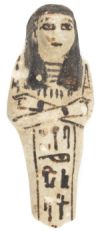Egypt and the Near East
 The Egypt and Near East collections represent nearly 5,000 years of Mediterranean history from the Cypriot civilisation to the Roman Empire and comprise 2,300 ancient Egyptian, Sudanese and Near Eastern objects. Our mummy, Lady Shep en Hor and other objects come from Egypt, one of the most ancient and wealthy civilisations. Egypt traded with many foreign neighbours including Libya, Nubia and the mysterious Land of Punt (in Eastern Africa). Other trading partners included the Greek city states and the cities of the Aegean, the Levant and the Near East. Egypt also received luxury goods from the Far East which arrived via the Silk Road.
The Egypt and Near East collections represent nearly 5,000 years of Mediterranean history from the Cypriot civilisation to the Roman Empire and comprise 2,300 ancient Egyptian, Sudanese and Near Eastern objects. Our mummy, Lady Shep en Hor and other objects come from Egypt, one of the most ancient and wealthy civilisations. Egypt traded with many foreign neighbours including Libya, Nubia and the mysterious Land of Punt (in Eastern Africa). Other trading partners included the Greek city states and the cities of the Aegean, the Levant and the Near East. Egypt also received luxury goods from the Far East which arrived via the Silk Road.
The Hunterian contains objects from some of the most important and iconic excavations of the 20th century in Egypt and Near East conducted by such people as William Matthew Flinders Petrie (1853-1942), Professor John Garstang (1876-1956) and Dame Kathleen Mary Kenyon, DBE (1906 - 1978). The Hunterian received material from the excavators as well as from the British School of Archaeology in Egypt, the Egypt Exploration Society and the British School of Archaeology in Jerusalem.
The type of objects represented in the collection is diverse and ranges from tiny amulets and beads to large stone steale. The collection also includes an early 19th century cast of the Rosetta stone presented to the University of Glasgow by the Marquis of Douglas on 16 March 1803. University of Glasgow Archives Services holds the records of the Glasgow Egypt Society (1912-1939) whose aims were to "promote the interests of excavation and research in Egypt".

